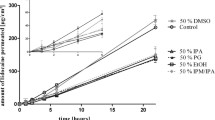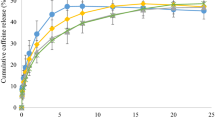Abstract
The effects of Azone and lauryl alcohol on the permeability of shed snakeskin were examined. Permeability of a variety of compounds through shed snakeskin was increased after Azone or lauryl alcohol pretreatment but the magnitude of the enhancement varied depending on the lipophilicity and the molecular size of the permeant. It was found that the shed snakeskin became more permeable after Azone or lauryl alcohol pretreatment, with a greater permeability increase for more hydrophilic and larger-molecular size permeants. As has been shown for untreated shed snakeskins, both the lipophilicity and the molecular size of the permeants are important in skin penetration and in determining the effects of transdermal penetration enhancers.
Similar content being viewed by others
REFERENCES
R. B. Stoughton. Enhanced percutaneous penetration with 1-dodecylazacycloheptan-2-one. Arch. Dermatol. 118:474–477 (1982).
R. B. Stoughton and W. O. McClure. Azone: A new non-toxic enhancer of cutaneous penetration. Drug Dev. Ind. Pharm. 9:725–744 (1983).
E. R. Cooper. Increased skin permeability for lipophilic molecules.J. Pharm. Sci. 73:1153–1156 (1984).
B. W. Barry. Mode of action of penetration enhancers in human skin. J. Control. Release 6:85–97 (1987).
N. Tsuzuki, O. Wong, and T. Higuchi. Effect of primary alcohols on percutaneous absorption. Int. J. Pharm. 46:19–23 (1988).
A. Ghanem, H. Mahmoud, W. I. Higuchi, V. D. Rohr, S. Borsadia, P. Liu, J. L. Fox, and W. R. Good. The effects of ethanol on the transport of beta-estradiol and other permeants in hairless mouse skin. II. A new quantitative approach. J. Control. Release 6:75–83 (1987).
B. Berner, G. C. Mazzenga, J. H. Otte, R. J. Steffens, R. Juang, and C. D. Ebert. Ethanol:water mutually enhanced transdermal therapeutic system. II. Skin permeation of ethanol and nitroglycerin. J. Pharm. Sci. 78:402–407 (1989).
G. M. Golden, J. E. McKie, and R. O. Potts. Role of stratum corneum lipid fluidity in transdermal drug flux. J. Pharm. Sci. 76(l):25–28 (1987).
P. P. Sarpotdar, J. L. Gaskill, and R. P. Giannini. Effect of polyethylene glycol 400 on the penetration of drugs through human cadaver skin in vitro. J. Pharm. Sci. 75:26–28 (1986).
R. Vaidyanathan, M. G. Chaubal, and R. C. Vasavada. Effect of pH and solubility on in vitro skin penetration of methotrexate from a 50% v/v propylene glycol-water vehicle. Int. J. Pharm. 25:85–93 (1985).
Y. Ito, T. Ogiso, and M. Iwaki. Thermodynamic study on enhancement of percutaneous penetration of drugs by azone. J. Pharmacobio-Dyn. 11:749–757 (1988).
T. Itoh, J. Xia, R. Magavi, T. Nishihata, and J. H. Rytting. Use of shed snake skin as a model membrane for in vitro percutaneous penetration studies: Comparison with human skin. Pharm. Res. 7:1042–1047 (1990).
T. Itoh, R. Magavi, R. L. Casady, T. Nishihata, and J. H. Rytting. A method to predict the percutaneous permeability of various compounds: Shed snake skin as a model membrane. Pharm. Res. 7:1302–1306 (1990).
M. Akazawa, T. Itoh, K. Masaki, B. T. Nghiem, N. Tsuzuki, R. Konishi, and T. Higuchi. An automated method for continuously monitoring diffusion cells in skin penetration studies. Int. J. Pharm. 50:53–60 (1989).
R. H. Guy and J. Hadgraft. Physicochemical aspects of percutaneous penetration and its enhancement. Pharm. Res. 5:753–758 (1988).
G. B. Kasting, R. L. Smith, and E. R. Cooper. Effects of lipid solubility and molecular size on percutaneous absorption. In B. Shroot and H. Schaefer (eds.), Skin Pharmacokinetics, Karger, Basel, 1987, pp. 138–153.
D. S.-L. Chow, I. Kaka, and T. I. Wang. Concentration-dependent enhancement of 1-dodecylazacycloheptan-2-one on the percutaneous penetration kinetics of triamcinolone acetonide. J. Pharm. Sci. 73:1794–1799 (1984).
S. C. Valvani and S. H. Yalkowski. Solubility and partitioning in drug design. In S. H. Yalkowski, A. A. Sinkula, and S. C. Valvani (eds.), Physical Chemical Properties of Drugs, Marcel Dekker, New York, 1980, pp. 201–229.
Author information
Authors and Affiliations
Rights and permissions
About this article
Cite this article
Itoh, T., Wasinger, L., Turunen, T.M. et al. Effects of Transdermal Penetration Enhancers on the Permeability of Shed Snakeskin. Pharm Res 9, 1168–1172 (1992). https://doi.org/10.1023/A:1015851805563
Issue Date:
DOI: https://doi.org/10.1023/A:1015851805563




